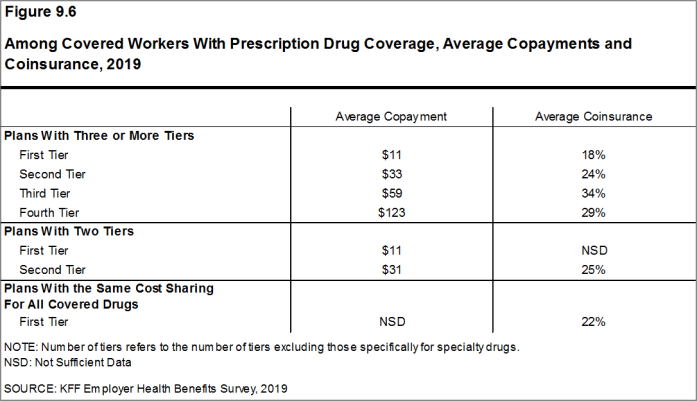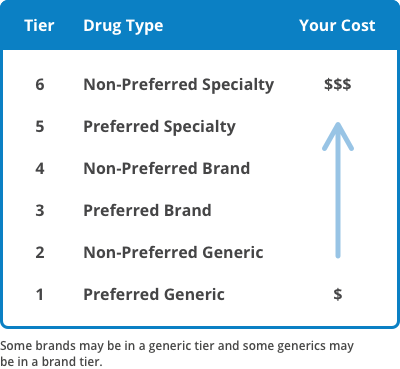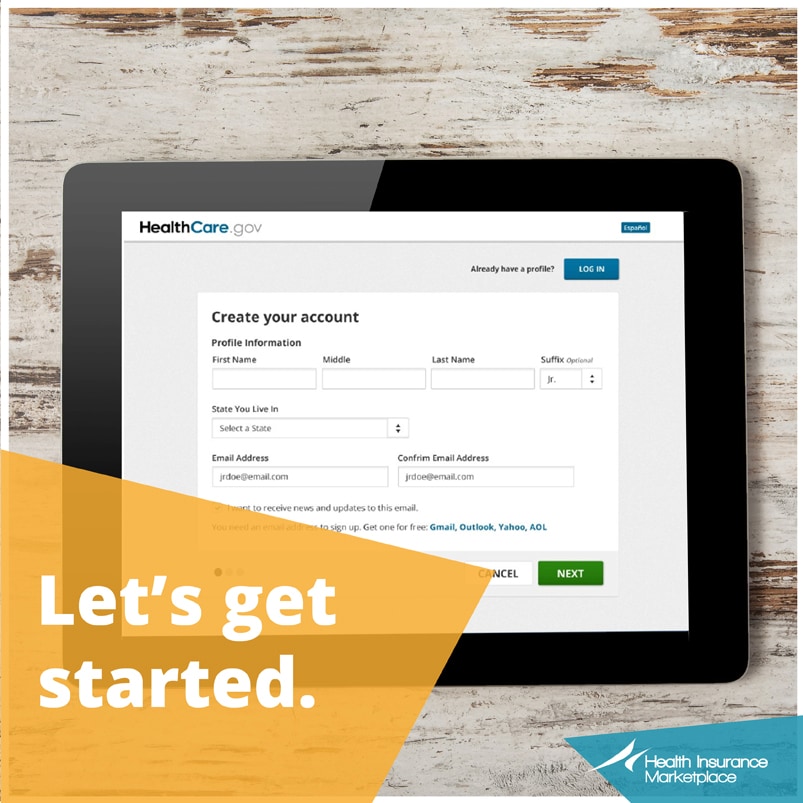Generic drugs which could be low-cost preferred generics or general preferred generics. There is not any one correct tier structure for a formulary.

Non-preferred generic and non-preferred brand name drugs.

What are tier 6 drugs. If you must take a brand-name you should work with your doctor to choose an appropriate one from Tier 2 as theyre the most affordable. The prescription drug tier which consists of some of the highest-cost prescription drugs most are specialty drugs. Preferred Generic Tier 1 Non-Preferred Generic Tier 2 Preferred Brand Tier 3 Non-Preferred Brand Tier 4 Preferred Specialty Tier 5 and Non-Preferred Specialty Tier 6.
Tier 6 Non Preferred Specialty drugs Specialty drugs filled by a specialty pharmacy and limited to a 30-day supply are prescription medications that often require special storage handling and close monitoring by you your doctor or pharmacist. Non-preferred and expensive brand-name drugs are usually in this tier. Reminder about Our 6-Tier Formulary.
Covered prescription drugs are assigned to 1 of 4 different levels with corresponding copayment or coinsurance amounts. Tier 1 Preferred generic drugs - 0 co-pay. Preferred Generic Tier 1 Non-Preferred Generic Tier 2 Preferred Brand Tier 3 Non-Preferred Brand Tier 4 Preferred Specialty Tier 5 and Non-Preferred Specialty Tier 6.
Also may include some nonspecialty brand or - generic drugs that have more cost-effective options at lower tiers. Medications on this tier have the lowest copayment. Tier 4 is where you find prescriptions with the highest cost mostly specialty drugs.
Tier 6 Non Preferred Specialty drugs Specialty drugs filled by a specialty pharmacy and limited to a 30-day supply are prescription medications that often require special storage handling and close monitoring. In some plans some cheaper brand-name drugs fall under Tier 1. Lower-cost commonly used generic drugs.
Specialty drugs are used to treat complex. How Are Drugs Priced on the Tiers. This list shows prescription drug products in tiers.
This tier includes some generics and brand-name drugs. More expensive generic drugs and preferred brand-name drugs occupy this tier. Generally each drug is placed into one of six member payment tiers.
Generally each drug is placed into one of up to six member payment tiers. Tier 4 Non-preferred brand name drugs - 35 of retail cost-sharing. Brand-name drugs including preferred and nonpreferred options.
This tier includes some generics and brand-name drugs. Medications on this tier have the lowest copayment. This is the highest copayment tier and includes some generics and brand-name covered drugs not selected for Tier 2.
On five- and six-tier systems the first tier is preferred generics. Tier 2 will have non-preferred generics and on up as in the four-tier formulary. Tier 6 is designed to offer an affordable option for some of the most commonly needed drugs and tend to cover only those specific drugs.
The exception to this is any drug or category specifically. This is the highest copayment tier and includes some generics and brand-name covered drugs not selected for Tier 2. Tier 6 Specialty drugs that have more cost-effective alternatives at Tier 5.
Level or Tier 1. Effective options at lower tiers. Medications in the 6 th tier have NO copay.
This tier includes many generic drugs. Prescription drug pricing varies according to the insurer. Level or Tier 2.
This tier includes many generic drugs. 6 rijen These are the most expensive drugs on the drug list. These drugs offer a medium co-payment and are often brand name drugs that are usually more affordable.
Tier 3 Preferred brand-name drugs - 25 of retail cost-sharing. Many common brand name drugs called preferred brands and some higher-cost generic drugs. Tier 6 tends to refer to a few generic drugs for diabetes and high cholesterol available with some specific insurance plans.
These drugs have the highest co-payment and are often brand-name drugs that have a generic version available. These drugs offer the lowest co-payment and are often generic version of brand name drugs. Medications on this tier are subject to the middle copayment.
Level or Tier 3. Our Blue Medicare PPO Enhanced and Blue Medicare HMO Enhanced plans include a 6-tier prescription drug formulary. Medications on this tier are subject to the middle copayment.
These drugs will cost you a significant amount out-of-pocket. Members can benefit from cost-savings opportunities when they are prescribed a medication in Tier 6. As an example a plan may form drug tiers this way.
Tier 2 Generic drugs - 10 co-pay. The prescription drug tier which consists of high-cost prescription drugs most are brand-name prescription drugs. The prescription drug tier which consists of the higher-cost prescription drugs most are brand-name prescription drugs and some specialty drugs.
 Section 9 Prescription Drug Benefits 9335 Kff
Section 9 Prescription Drug Benefits 9335 Kff
Https Www Uhcsr Com Media 0f2c9f9d B8a9 4432 Bf64 A23828328fb3
 Enhanced Drug Network Focused On Vascular Dementia A The Network Is Download Scientific Diagram
Enhanced Drug Network Focused On Vascular Dementia A The Network Is Download Scientific Diagram
 The Out Of Pocket Cost Burden For Specialty Drugs In Medicare Part D In 2019 Kff
The Out Of Pocket Cost Burden For Specialty Drugs In Medicare Part D In 2019 Kff
 The Effect Of Incentive Based Formularies On Prescription Drug Utilization And Spending Nejm
The Effect Of Incentive Based Formularies On Prescription Drug Utilization And Spending Nejm
 Getting The Most Out Of Commercial Drug Insurance The Diabetes Prescription
Getting The Most Out Of Commercial Drug Insurance The Diabetes Prescription
 Janis E Carter Health Net Health Net Medicare Advantage Sales Product Training Proprietary Confidential Restricted Distribution For Training Purposes Ppt Download
Janis E Carter Health Net Health Net Medicare Advantage Sales Product Training Proprietary Confidential Restricted Distribution For Training Purposes Ppt Download
 See 2021 Prescription Drug Changes Blue Cross And Blue Shield Of Illinois
See 2021 Prescription Drug Changes Blue Cross And Blue Shield Of Illinois
 Your 2013 Prescription Drug List Quick Reference Guide
Your 2013 Prescription Drug List Quick Reference Guide
Http Senderohealth Com Files 2020 71837tx001000600 Soc Rx Pdf
Https Www Myprime Com Content Dam Prime Memberportal Forms Authorforms Him 2020 2020 Nc 6t Healthinsurancemarketplace Pdf
 Table 7 From Employer Drug Benefit Plans And Spending On Prescription Drugs Semantic Scholar
Table 7 From Employer Drug Benefit Plans And Spending On Prescription Drugs Semantic Scholar



No comments:
Post a Comment
Note: Only a member of this blog may post a comment.